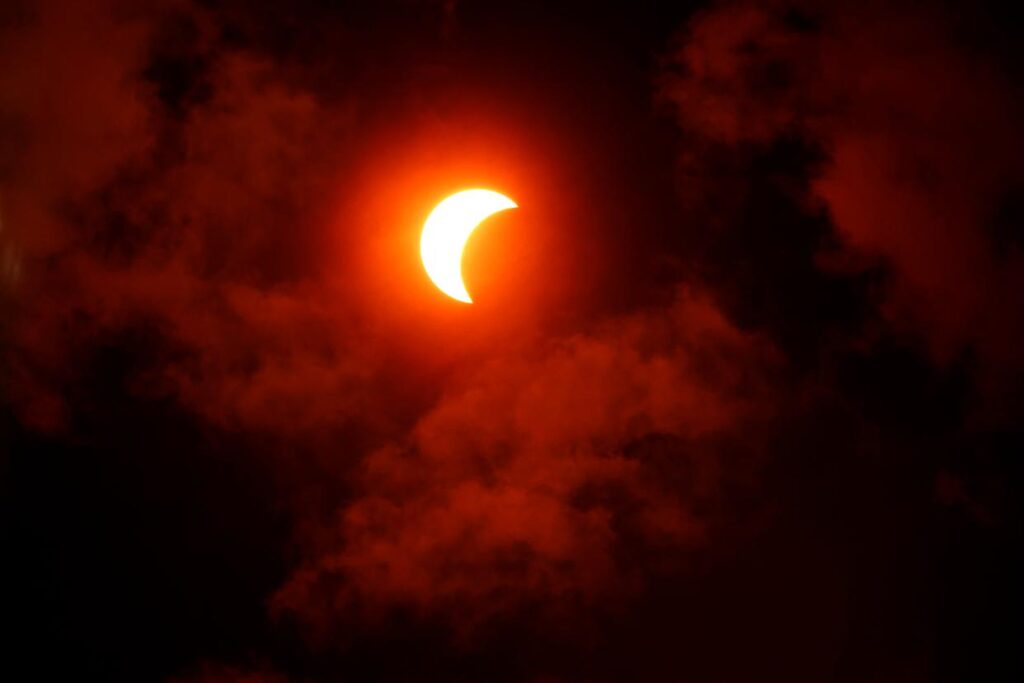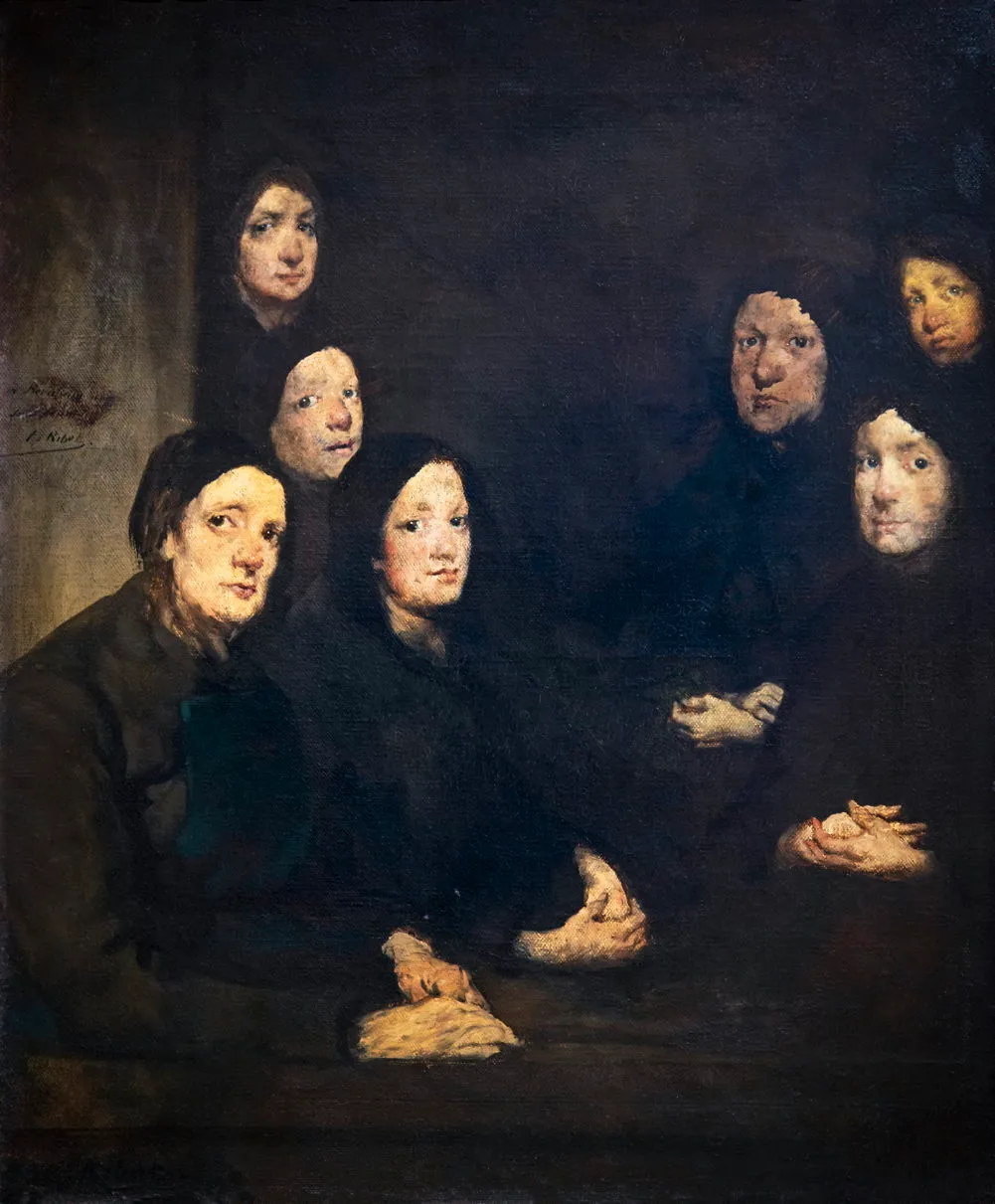The heavens prepare a scenario of deep weight as the Sun and Moon join in the final degree of Virgo for a partial solar eclipse. Both luminaries and the regent Mercury will stand in the bounds of Saturn, whilst Saturn himself opposes them directly from Pisces, retrograde and in his own Egyptian bound too. It is a passage of discipline, limit and purification. The eclipse occurs at the very end of Virgo, a degree of exhaustion, where cycles complete in labour and the body feels the grain of matter.
The eclipse coincides with the second New Moon in Virgo within one lunation cycle, an unusual insistence that repeats the theme of service, purification and the labour of the flesh. The conjunction takes place at the South Node, the Cauda Draconis, which consumes and drains what has grown excessive. It is a moment in which light is veiled, the Logos darkened. The symbolism is dense with the language of Saturn.

In the Tree of Life the event is a movement through the central column. Gabriel lifts the veil of Yesod and partially places it before the heart of Tifereth. Sandalfon holds the earth in silence at Malkuth, whereas Michael sustains the beauty of the Sun in Tifereth half hidden. Above them, Binah casts her shadow of form and law, as Saturn is her planet.
The partial eclipse will be a rite of balance in which light is allowed to shine only through the filter of limit. The Sun, Logos of the cosmos, is momentarily judged by the Moon, who in Virgo has nocturnal dignity by triplicity. She holds legitimate authority to veil, since the labour of the earth must answer to the cycles of night and day.
I. The Weight of Saturn
The eclipse takes place under Saturnalian dominion at many levels. The Sun is in the bound of Saturn in Virgo, the last breath of mutable earth. Mercury, ruler of Virgo and regent of the eclipse, has already crossed into Libra but also within a Saturnine bound. Saturn is retrograde in Pisces, in his own bound, opposing the Sun and Moon across the axis of service and sacrifice. The aspect is separative by less than a degree; the mark of the scythe still fresh. Saturn is the planet of law, silence, endurance and necessity. His retrograde position in mutable water deepens the sense of return and repetition, echoing the double New Moon in Virgo. What is left unfinished must be faced again.
Pisces, the place of Saturn at this eclipse, corresponds to the house of hidden enemies in the language of the ancients, the Cacodaimon. Virgo, where the eclipse occurs, corresponds to the Bad Fortune sixth house, the place of toil, sickness and labour. The two work as an axis of hardship. That the Sun and Moon are veiled across this axis while Saturn casts his opposition makes the image clear: the work of purification is enforced. This is a moment when cycles of excess are ended by necessity, when the Logos is clothed in shadow so that it may emerge leaner.
The South Node magnifies this tone. At the Cauda Draconis things are drained, pulled into dissolution. An eclipse at the South Node is never growth but subtraction. With Saturn ruling the bounds, the subtraction is stern. The eclipse becomes an act of cutting away, of detachment, of letting the harvest rot so that the soil may rest.
II. The Dance of the Angels
The Kabbalistic image of this eclipse is striking. On the central pillar, Sandalfon protects Malkuth below, Gabriel veils Yesod in the middle, Michael guards Tifereth above. The Sun is therefore veiled by the Moon. The image is of the Logos tested. The splendour is partially concealed.
The presence of Saturn calls Binah into the axis. Binah is the Mother of form, the place of understanding, the dark sea that limits. She is the celestial face of Saturn. When Binah speaks, the Logos listens. The eclipse is under her word. The Sun is weighed in the scales of discipline before crossing into Libra, sign of its equinoxial fall.
Through the veil, transformation is possible. The eclipse point is in trine to Uranus retrograde in Gemini and to Pluto retrograde in Aquarius. The Logos veiled is also Logos transfigured. Uranus opens the mind to sudden insight; Pluto remakes the collective body. The eclipse carries weight and opening. It closes what is worn out but grants passage into change.
The regent Mercury embodies this mediation. He stands in Libra, under Saturn’s bound, still feeling a separation from the Sun and an application to the Moon. He is Hermes between the two, connecting heart and womb. He ensures that the Word is not lost in the eclipse, but carried through shadow to be spoken again.
III. The Spiritual Meaning of Virgo
That this eclipse occurs in Virgo is itself important. The sign is the place of the body, the grain, the daily labour. In Kabbalah it corresponds to the work of separating the pure from the impure and to one of the columns of the Temple of Solomon. It is the sign of the small sacrifice that allows the larger work to stand. The ancients placed the Moon as nocturnal ruler of the triplicity of Earth. Thus, in Virgo, the Moon has authority to veil the Sun, as the Lady performs her office as High Priestess of matter.
This eclipse carries the rare mark of two New Moons in Virgo within a single cycle. The first was born under the shadow of a total lunar eclipse in Pisces; the second now unfolds as a partial solar eclipse in Virgo. Mutable earth and mutable water answer one another in a dialogue of purification and dissolution.
The double Virgoan call is a repetition that insists upon the work of service and separation. The Moon first revealed the weight of Pisces in fullness, drenched in its eclipse, and now obscures the Sun at the moment of concealment. It is a sequence that drains through water and cuts through earth, asking that what is impure be washed away and what is excessive be sifted from the harvest.
Κύριε ελέησον
